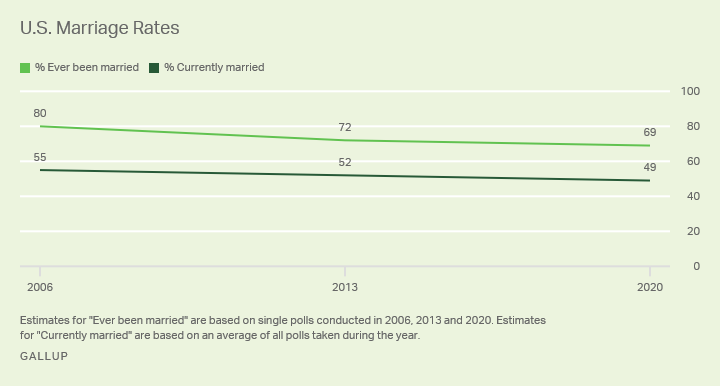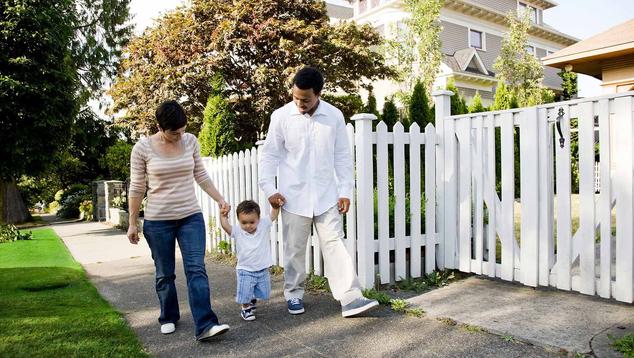Story Highlights
- 29% say it is very important for a couple to marry if they have a child
- Down from 38% in 2013
- Fewer say it is important for couples to marry to spend lives together
WASHINGTON, D.C. -- Americans are less inclined now than in recent years to see marriage as critical for couples who have children together or for couples who plan to spend the rest of their lives together. Most U.S. adults have been married at some point in their lives, but those figures are declining. Still, the vast majority of adults who have never been married remain interested in getting married someday.
Americans See Marriage as Less Important for Couples With Children Together
Fewer U.S. adults now than in past years believe it is "very important" for couples who have children together to be married. Currently, 29% say it is very important that such a couple legally marry, down from 38% who held this view in 2013 and 49% in 2006.

Line graph. Since 2006 fewer Americans have said it is very important that a couple with a child together legally marry and more have said it is not important that they do so.
Another 31% of U.S. adults currently say it is "somewhat important" for couples with children to be married, bringing the total to 60% who consider it important to some degree. Meanwhile, four in 10 say it is not too (18%) or not at all (22%) important.
In 2006, Americans were more than twice as likely to say it is very important (49%) for couples with children to wed as to say it is not important (23%).
The latest results are based on Gallup's annual Values and Beliefs poll, conducted May 1-13. The poll updated several trends on Americans' views about marriage asked previously over the past two decades.
The trends are consistent with Americans' evolving views of marriage. Sixty-six percent now believe it is morally acceptable to have a baby outside of marriage, an increase from 53% the first year the question was asked in 2001. Seventy-two percent, up from 53% in 2001, consider sex between an unmarried man and woman morally acceptable.
Most key subgroups are less likely now than in 2013, and all are less likely than in 2006, to view it as critical that couples with children together legally marry. Political liberals and young adults are two groups whose opinions have not changed appreciably in the past seven years.
| 2006 | 2013 | 2020 | Change, 2006-2020 | ||||||||||||||||||||||||||||||||||||||||||||||||||||||||||||||||||||||||||||||||||||||||||||||||
|---|---|---|---|---|---|---|---|---|---|---|---|---|---|---|---|---|---|---|---|---|---|---|---|---|---|---|---|---|---|---|---|---|---|---|---|---|---|---|---|---|---|---|---|---|---|---|---|---|---|---|---|---|---|---|---|---|---|---|---|---|---|---|---|---|---|---|---|---|---|---|---|---|---|---|---|---|---|---|---|---|---|---|---|---|---|---|---|---|---|---|---|---|---|---|---|---|---|---|---|
| % | % | % | pct. pts. | ||||||||||||||||||||||||||||||||||||||||||||||||||||||||||||||||||||||||||||||||||||||||||||||||
| Men | 53 | 37 | 29 | -24 | |||||||||||||||||||||||||||||||||||||||||||||||||||||||||||||||||||||||||||||||||||||||||||||||
| Women | 45 | 39 | 28 | -17 | |||||||||||||||||||||||||||||||||||||||||||||||||||||||||||||||||||||||||||||||||||||||||||||||
| 18-34 years old | 30 | 22 | 22 | -8 | |||||||||||||||||||||||||||||||||||||||||||||||||||||||||||||||||||||||||||||||||||||||||||||||
| 35-54 years old | 49 | 35 | 23 | -26 | |||||||||||||||||||||||||||||||||||||||||||||||||||||||||||||||||||||||||||||||||||||||||||||||
| 55+ years old | 63 | 53 | 38 | -25 | |||||||||||||||||||||||||||||||||||||||||||||||||||||||||||||||||||||||||||||||||||||||||||||||
| White adults | 45 | 37 | 27 | -18 | |||||||||||||||||||||||||||||||||||||||||||||||||||||||||||||||||||||||||||||||||||||||||||||||
| Non-White adults | 57 | 41 | 33 | -24 | |||||||||||||||||||||||||||||||||||||||||||||||||||||||||||||||||||||||||||||||||||||||||||||||
| College graduate | 41 | 31 | 25 | -16 | |||||||||||||||||||||||||||||||||||||||||||||||||||||||||||||||||||||||||||||||||||||||||||||||
| Not college graduate | 51 | 41 | 31 | -20 | |||||||||||||||||||||||||||||||||||||||||||||||||||||||||||||||||||||||||||||||||||||||||||||||
| Conservative | 62 | 55 | 41 | -21 | |||||||||||||||||||||||||||||||||||||||||||||||||||||||||||||||||||||||||||||||||||||||||||||||
| Moderate | 42 | 33 | 22 | -20 | |||||||||||||||||||||||||||||||||||||||||||||||||||||||||||||||||||||||||||||||||||||||||||||||
| Liberal | 30 | 18 | 21 | -9 | |||||||||||||||||||||||||||||||||||||||||||||||||||||||||||||||||||||||||||||||||||||||||||||||
| Republican | 62 | 49 | 36 | -26 | |||||||||||||||||||||||||||||||||||||||||||||||||||||||||||||||||||||||||||||||||||||||||||||||
| Independent | 42 | 35 | 29 | -13 | |||||||||||||||||||||||||||||||||||||||||||||||||||||||||||||||||||||||||||||||||||||||||||||||
| Democrat | 42 | 33 | 18 | -24 | |||||||||||||||||||||||||||||||||||||||||||||||||||||||||||||||||||||||||||||||||||||||||||||||
| Married | 55 | 44 | 33 | -22 | |||||||||||||||||||||||||||||||||||||||||||||||||||||||||||||||||||||||||||||||||||||||||||||||
| Not married | 39 | 31 | 25 | -14 | |||||||||||||||||||||||||||||||||||||||||||||||||||||||||||||||||||||||||||||||||||||||||||||||
| Children under 18 | 48 | 32 | 30 | -18 | |||||||||||||||||||||||||||||||||||||||||||||||||||||||||||||||||||||||||||||||||||||||||||||||
| No children under 18 | 48 | 41 | 27 | -21 | |||||||||||||||||||||||||||||||||||||||||||||||||||||||||||||||||||||||||||||||||||||||||||||||
| Attend church weekly | 65 | 58 | 45 | -20 | |||||||||||||||||||||||||||||||||||||||||||||||||||||||||||||||||||||||||||||||||||||||||||||||
| Attend church monthly | 58 | 41 | 32 | -26 | |||||||||||||||||||||||||||||||||||||||||||||||||||||||||||||||||||||||||||||||||||||||||||||||
| Seldom/Never attend | 32 | 24 | 19 | -13 | |||||||||||||||||||||||||||||||||||||||||||||||||||||||||||||||||||||||||||||||||||||||||||||||
| Gallup | |||||||||||||||||||||||||||||||||||||||||||||||||||||||||||||||||||||||||||||||||||||||||||||||||||
Frequent church attendees (45%), political conservatives (41%) and Americans aged 55 and older (38%) and are among the groups most likely to believe marriage is crucial for parents. Democrats (18%), those who seldom or never attend church (19%), political liberals (21%) and moderates (22%), and adults under age 55 (23%) are among the groups least likely to regard marriage as being very important for such couples.
Parents of minor children (30%) are not significantly more likely than nonparents (27%) to view marriage as critical. Those who are currently married (33%) are slightly more likely than those who are not married (25%) to say it is important, though the current eight-percentage-point gap between these two groups has narrowed from 16 points in 2006.
Americans More Inclined to See Marriage as Critical for Life Partners
A separate question in the survey finds Americans are more likely to believe it is very important for couples to marry if they plan to spend the rest of their lives together (38%) than if they have a child together. Twenty-six percent think it is somewhat important for couples who plan to spend their lives together to get married, while 15% say it is not too important and 21% say it is not important at all.
As with the decline in public insistence that couples with children marry, fewer today than in the recent past say it is important that committed couples marry. The current 38% who say it is very important for couples to marry if they plan to live together the rest of their lives is down slightly from 43% in 2013 and more substantially from 54% in 2006.

Line graph. Since 2006 sharply fewer Americans have said it is very important that a couple marry if they plan to spend the rest of their lives together.
Religiosity and political ideology are the strongest predictors of the importance people attach to couples marrying when they want to spend their lives together.
-
Sixty-seven percent of weekly church attendees regard marriage as very important for couples who want to spend their lives together, compared with 22% of those who rarely or never attend church.
-
Fifty-five percent of conservatives versus 23% of liberals believe it is very important that such couples wed.
There are also significant differences by age, partisanship, race and education. Older Americans, Republicans, non-White adults and college nongraduates place more importance on marriage for couples who want to live together than do younger Americans, Democrats, White adults and college graduates.
All key subgroups are less likely now than in 2006 to believe it is very important for couples to marry if they plan to live together the rest of their lives.
| 2006 | 2013 | 2020 | Change, 2006-2020 | ||||||||||||||||||||||||||||||||||||||||||||||||||||||||||||||||||||||||||||||||||||||||||||||||
|---|---|---|---|---|---|---|---|---|---|---|---|---|---|---|---|---|---|---|---|---|---|---|---|---|---|---|---|---|---|---|---|---|---|---|---|---|---|---|---|---|---|---|---|---|---|---|---|---|---|---|---|---|---|---|---|---|---|---|---|---|---|---|---|---|---|---|---|---|---|---|---|---|---|---|---|---|---|---|---|---|---|---|---|---|---|---|---|---|---|---|---|---|---|---|---|---|---|---|---|
| % | % | % | pct. pts. | ||||||||||||||||||||||||||||||||||||||||||||||||||||||||||||||||||||||||||||||||||||||||||||||||
| Men | 56 | 43 | 39 | -17 | |||||||||||||||||||||||||||||||||||||||||||||||||||||||||||||||||||||||||||||||||||||||||||||||
| Women | 53 | 43 | 38 | -15 | |||||||||||||||||||||||||||||||||||||||||||||||||||||||||||||||||||||||||||||||||||||||||||||||
| 18-34 years old | 50 | 34 | 29 | -21 | |||||||||||||||||||||||||||||||||||||||||||||||||||||||||||||||||||||||||||||||||||||||||||||||
| 35-54 years old | 46 | 41 | 40 | -6 | |||||||||||||||||||||||||||||||||||||||||||||||||||||||||||||||||||||||||||||||||||||||||||||||
| 55+ years old | 67 | 54 | 43 | -24 | |||||||||||||||||||||||||||||||||||||||||||||||||||||||||||||||||||||||||||||||||||||||||||||||
| White adults | 51 | 41 | 34 | -17 | |||||||||||||||||||||||||||||||||||||||||||||||||||||||||||||||||||||||||||||||||||||||||||||||
| Non-White adults | 63 | 50 | 48 | -15 | |||||||||||||||||||||||||||||||||||||||||||||||||||||||||||||||||||||||||||||||||||||||||||||||
| College graduate | 38 | 32 | 31 | -7 | |||||||||||||||||||||||||||||||||||||||||||||||||||||||||||||||||||||||||||||||||||||||||||||||
| Not college graduate | 62 | 48 | 42 | -20 | |||||||||||||||||||||||||||||||||||||||||||||||||||||||||||||||||||||||||||||||||||||||||||||||
| Conservative | 74 | 63 | 55 | -19 | |||||||||||||||||||||||||||||||||||||||||||||||||||||||||||||||||||||||||||||||||||||||||||||||
| Moderate | 47 | 37 | 34 | -13 | |||||||||||||||||||||||||||||||||||||||||||||||||||||||||||||||||||||||||||||||||||||||||||||||
| Liberal | 31 | 22 | 23 | -8 | |||||||||||||||||||||||||||||||||||||||||||||||||||||||||||||||||||||||||||||||||||||||||||||||
| Republican | 73 | 56 | 51 | -22 | |||||||||||||||||||||||||||||||||||||||||||||||||||||||||||||||||||||||||||||||||||||||||||||||
| Independent | 49 | 38 | 36 | -13 | |||||||||||||||||||||||||||||||||||||||||||||||||||||||||||||||||||||||||||||||||||||||||||||||
| Democrat | 45 | 39 | 27 | -18 | |||||||||||||||||||||||||||||||||||||||||||||||||||||||||||||||||||||||||||||||||||||||||||||||
| Married | 60 | 49 | 43 | -17 | |||||||||||||||||||||||||||||||||||||||||||||||||||||||||||||||||||||||||||||||||||||||||||||||
| Not married | 45 | 37 | 33 | -12 | |||||||||||||||||||||||||||||||||||||||||||||||||||||||||||||||||||||||||||||||||||||||||||||||
| Children under 18 | 56 | 40 | 43 | -13 | |||||||||||||||||||||||||||||||||||||||||||||||||||||||||||||||||||||||||||||||||||||||||||||||
| No children under 18 | 54 | 45 | 36 | -18 | |||||||||||||||||||||||||||||||||||||||||||||||||||||||||||||||||||||||||||||||||||||||||||||||
| Attend church weekly | 82 | 68 | 67 | -15 | |||||||||||||||||||||||||||||||||||||||||||||||||||||||||||||||||||||||||||||||||||||||||||||||
| Attend church monthly | 62 | 50 | 46 | -16 | |||||||||||||||||||||||||||||||||||||||||||||||||||||||||||||||||||||||||||||||||||||||||||||||
| Seldom/Never attend | 33 | 26 | 22 | -11 | |||||||||||||||||||||||||||||||||||||||||||||||||||||||||||||||||||||||||||||||||||||||||||||||
| Gallup | |||||||||||||||||||||||||||||||||||||||||||||||||||||||||||||||||||||||||||||||||||||||||||||||||||
Desire for Marriage Still Strong; Most Have Been Married
The lesser importance Americans place today on being married is borne out to some degree in the trends in marriage rates. The poll finds that most Americans (69%) have been married at some point in their lives -- encompassing those currently married, divorced or widowed. While this rate is similar to the 72% found in 2013 when the question was last asked, it is down from 80% in 2006.
In terms of those currently married, 49% report this today, also down from 55% in 2006.

Line graph. The percentage of U.S. adults who have been married at some point in their lives has fallen from 80% in 2006 to 72% in 2013 and 69% now. The percentage of U.S. adults who are currently married has fallen from 55% in 2006 to 52% in 2013 and 49% now.
The percentage of those currently married has shown greater decline when compared with historical Gallup trends. Between 1978 and 1983, a consistent 64% of Gallup poll respondents reported being married. The percentage fell below 60% in the mid-1990s and has been below 50% since 2015.
Much of that decline in the marriage rate in the past four decades is accounted for by the 8% who say they are unmarried but living with a partner -- a category not included in Gallup surveys prior to 1999. The percentage who report being divorced has also doubled, from 5% in the late 1970s and early 1980s, to 10% since 2015, while the percentage who say they are single or never married has increased modestly from 20% to 22%.
Despite this slide in marital rates, the vast majority of U.S. adults who have not been married -- 81% -- say they would like to get married someday. This is essentially unchanged from 78% when the question was last asked, in 2013.
Therefore, while people may think it is less important for couples to marry regardless of the situation, it is still a choice most people make, or hope to make, for themselves.
Bottom Line
Americans' attitudes about marriage continue to evolve, with fewer saying it is important for couples to marry if they have children together or if they want to spend the rest of their lives together. These trends are consistent with changes in U.S. attitudes on a variety of moral values issues, which have moved in a less traditional direction over the past two decades. Solid majorities of Americans now view sex between an unmarried man and woman, same-sex relations, and having a baby outside of marriage as being morally acceptable.
While the marriage rate is declining, the desire of those who have never been married to get married someday remains high, with more than eight in 10 singles hoping to marry. Thus, their evolving attitudes about marriage may reflect increasing acceptance for how others lead their lives rather than a profound shift in their own lifestyle preferences.
View complete question responses and trends (PDF download).
Learn more about how the Gallup Poll Social Series works.




